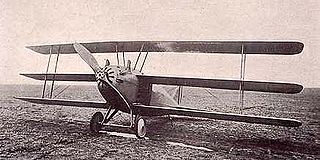
The Curtiss NC is a flying boat built by Curtiss Aeroplane and Motor Company and used by the United States Navy from 1918 through the early 1920s. Ten of these aircraft were built, the most famous of which is the NC-4, the first airplane to make a transatlantic flight. The NC-4 is preserved in the National Museum of Naval Aviation, at NAS Pensacola, Florida.

The twin-engine F5L was one of the Felixstowe F series of flying boats developed by John Cyril Porte at the Seaplane Experimental Station, Felixstowe, England, during the First World War for production in America.

The Curtiss Model N is a military trainer used primarily by the United States Navy during World War I.

The Curtiss 18T, unofficially known as the Wasp and by the United States Navy as the Kirkham, was an early American triplane fighter aircraft designed by Curtiss for the US Navy.

The Curtiss Eagle was an airliner produced in small numbers in the United States shortly after World War I. The aircraft was a conventional biplane with three-bay, unstaggered wings of equal span. The fuselage was a very advanced design for its day, incorporating careful streamlining of its monocoque structure, and offering the crew as well as the passengers a fully enclosed cabin. The Eagle is sometimes named as the first American tri-motor aircraft; however Curtiss' own Model H flying boat flew with three engines for a time in 1914 before being converted back to twin-engine configuration.

The Reid Rambler, later known under the Curtiss-Reid brand after Reid was purchased by Curtiss, was a biplane trainer/sport aircraft built in Canada in the early 1930s and used in small numbers as a trainer aircraft by the Royal Canadian Air Force.

The International F-17 Sportsman was a 1920s American three-seat open-cockpit biplane designed and manufactured by the International Aircraft Corporation in Long Beach, California and Cincinnati, Ohio. 107 aircraft were built, 77 of them at Cincinnati.

The Douglas XFD was a carrier-based biplane fighter aircraft designed for the United States Navy, and the first fighter to be built by the Douglas Aircraft Company. A victim of changing requirements, no production was undertaken.

The Loening S-1 Flying Yacht, also called the Loening Model 23, was an early light monoplane flying boat designed in the United States by Grover Loening in the early 1920s. The aircraft won the 1921 Collier Trophy.

The Lincoln-Page PT is an American open-cockpit two-seat single-bay biplane trainer aircraft produced from 1929 to 1931.

The Norman Thompson N.T.2B was a British single-engined flying boat trainer of the First World War. A single-engined biplane, the N.T.2B was adopted as a standard flying boat trainer by the Royal Naval Air Service, training pilots for larger patrol flying boats such as the Felixstowe F.2.

The American Eagle A-129 was an American biplane first flown in 1929.

The White & Thompson No. 1 Seaplane was the first British built twin-engined biplane flying boat, assembled just prior to the outbreak of the First World War to compete in an air-race around the UK. It was unsuccessful, only the single prototype being built.

The Wanamaker Triplane or Curtiss Model T, retroactively renamed Curtiss Model 3 was a large experimental four-engined triplane patrol flying boat of World War I. It was the first four-engined aircraft built in the United States. Only a single example (No.3073) was completed. At the time, the Triplane was the largest seaplane in the world.

The Vought XSO2U was an American observation floatplane developed by Vought-Sikorsky for the United States Navy during the late 1930s. Intended to replace the Curtiss SOC Seagull in service as a scout aboard cruisers, it proved superior to the Curtiss SO3C in evaluation, but failed to win a production contract due to Vought's lack of manufacturing capacity.
The Bird Wing or later, Bird Wing Imperial was a light sport biplane of the 1920s and 1930s.

The Curtiss Model J was a prototype tractor configuration aircraft that became the basis for the Curtiss Jenny series of aircraft.

The Curtiss CA-1 was an American five-seat biplane amphibian designed by Frank Courtney and built by Curtiss-Wright at St Louis, Missouri.

The Sperry Land and Sea Triplane was an American three seat amphibious aircraft designed as a coastal reconnaissance/bomber. Two examples were built and tested for the U.S. Navy towards the end of the First World War. The machine performed well on land and water, but no orders were placed.
The Keystone XOK was an American biplane observation floatplane developed for the United States Navy during the early 1930s.


















